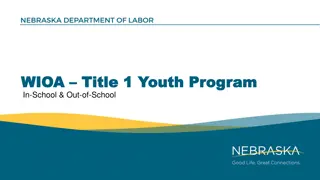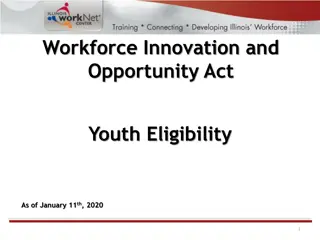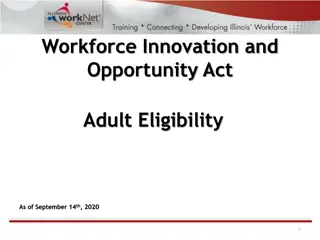Workforce Innovation and Opportunity Act: On-the-Job Training Overview
Providing insights into the On-the-Job Training (OJT) program under the Workforce Innovation and Opportunity Act, this document covers eligibility, reimbursement for businesses, historical changes, and common misconceptions about OJT. It details the purpose, populations served, defining features, and eligibility criteria for participants seeking training services through the program.
Download Presentation

Please find below an Image/Link to download the presentation.
The content on the website is provided AS IS for your information and personal use only. It may not be sold, licensed, or shared on other websites without obtaining consent from the author.If you encounter any issues during the download, it is possible that the publisher has removed the file from their server.
You are allowed to download the files provided on this website for personal or commercial use, subject to the condition that they are used lawfully. All files are the property of their respective owners.
The content on the website is provided AS IS for your information and personal use only. It may not be sold, licensed, or shared on other websites without obtaining consent from the author.
E N D
Presentation Transcript
Workforce Innovation and Opportunity Act ON-THE-JOB TRAINING
AGENDA Overview Eligibility Individual Training Accounts (ITAs), Training Contracts and/orAgreements General Restrictions and Guidelines On-the-Job Training and other training programs State and Local Monitoring Employ Florida Documentation Resources 1
BACKGROUND/PURPOSE On-the-Job Training (OJT): Is a proven, evidence-based strategy Provides for reimbursements to businesses (up to 75%) Provides employment services for unemployed and/or underemployed individuals through direct work experience 2
HISTORICALCHANGES 1. Sequence of services 2. Employer Reimbursement (up to 75%) 3. Alignment of performance measures with OJT 4. Training focuses on in-demand occupations 5. Connection between OJT and Registered Apprenticeships 3
DEFINING OJT OJT is defined as training by an employer that is provided to a participant while engaged in productive work in a job that: a. Provides knowledge or skills essential to the adequately perform the job; b. Is made available through a program that provides reimbursement to the employer of up to 50 % (up to 75%) of the wage rate of the participant; c. Pays the participant an hourly wage; and d. Is limited in duration (not to exceed twelve months) to the occupation for which the participant is being trained. 4
REVIEW 5
OJT COMMON MISPERCEPTIONS One-size does not fit all Not a work experience program Enhancement of skills for the participant Is not a wage subsidy Not a source for inexpensive or temporary labor Not an alternative for relocating businesses 6
OJT POPULATIONS OJT may be offered to: Adults Dislocated Workers Unemployed and/or underemployed workers In-School Youth (ISY) Out-of-School Youth (OSY) 7
ELIGIBILITY A participant who meets WIOA eligibility may be considered for OJT when: Eligibility requirements for the WIOA adult, dislocated worker or youth programs have been met; and The participant has been determined to be in need of training services. 8
EMPLOYED WORKERS OJT ELIGIBILITY OJT contracts may be written for employed workers when: The employee is not earning a self-sufficient wage or wages, as determined by the LWDB policy; The OJT relates to the introduction of new technologies, introduction to new production or service procedures, upgrading to new jobs that require additional skills, workplace literacy, or other appropriate skills; and There is a contract for the OJT with and employer or registered apprenticeship program sponsor in the public, private non-profit or private sector. 9
OJT OCCUPATION RESTRICTIONS Occupations that are not suitable for OJT are occupations: Based on commission; Seasonal in nature; or That are less than part-time. 10
REVIEW 11
DURATION OFASSIGNMENT: LWDBs must ensure that the OJT contracts are procured in accordance with federal, state and local procurement policies and shall not exceed a 12 month period. 12
OJT TRAINING PLAN/CONTRACT: LWDBs must ensure that the OJT plan and/or contract is: developed jointly with the participant and staff; based on the occupation the participant has selected; and detailed with the type of job training. 13
OJT CONTRACT REQUIREMENTS: 1. 2. 3. Name, address, and telephone number of the business/employer; Name of the contract administrator for the employer; Number of participants to be trained, specifying for each participant or position; Number of hours of training; Wage rate (including scheduled adjustments); Reimbursement rate; Job description for each training occupation; Training plan (see next section) for each slot or category indicating the occupational skills and knowledge to be learned in an orderly progression of training sequences; A description of any additional services to be provided beyond training; 10. Total maximum dollar amount of the agreement; 11. Beginning and ending dates of agreement; 12. Personnel responsible for supervision of the training; 4. 5. 6. 7. 8. 9. 14
OJT CONTRACT REQUIREMENTS CONTD: 13. Terms of agreement for job retention; 14. Record-keeping requirements, including participant time and attendance documentation and payroll records; 15. Invoicing/payment procedures, including frequency of billing and required supporting documentation; 16. Workers compensation, or if not applicable, alternative insurance for injuries to participants; 17. Assurances of no displacement of currently employed workers or infringement on promotional opportunities; 18. Signatures of authorizing official from employer/business and local board or entity, agreements and must be on record as the signatory official, and 19. General provisions and assurances. 15
OJT CONTRACT SAMPLE: OJT Contract Sample 16
REVIEW 17
PAYMENT, RECORDING WAGES AND PARTICIPANT HOURS Must be in compliance with WIOA program guidelines. LWDB must ensure that participant wages are equal to those similarly employed by the employer. The LWDB must ensure WIOA funds are not utilized to pay for the following: holidays; sick leave; vacation; overtime hours; fringe benefits; and/or work performed outside the OJT contract. LWDB must retain records for each OJT employer and OJT participant for a minimum of five years. 18
REVERSE REFERRAL A reverse referral is the referral of an individual to the career center from a prospective employer (under either formal or informal agreement) for assessment as to whether or not the individual meets the employer s hiring requirements for a specific position. 19
REVERSE REFERRALCONTD Reverse Referrals are only permitted when: the participant progresses through the intake and assessment process, meets all of the requirements for eligibility; the completed Individual Employment Plan (IEP) indicates training is necessary; the employer meets all of the eligibility requirements under the state policy; and the employer provides assurance that the individual has not previously been employed by the employer in the same or similar position. 20
LWDB ROLES & RESPONSIBILITIES LWDBs must ensure that the OJT: 1. Contract includes an explanation of how participants will be provided a structured training opportunity. 2. Participants are compensated at the same wage rates, including periodic increases, as trainees or employees who are in similar occupations by the same employer and who have similar training, experience, and skills. 3. Contracts are signed and dated by a representative from the LWDB, the employer and the OJT participant. 4. Contracts outline the requirements for the participant, employer and the local area, that are specific to the OJT training. 5. Contracts include any applicable provisions required by federal statutes and executive orders. 6. Contracts include employer responsibilities and required assurances that the employer will provide to the participant during and following the OJT 21
LWDB ROLES & RESPONSIBILITIES CONTD 7. No participant is placed in an OJT where a member of that person s immediate family is directly supervised by or directly supervises the participant. Employees were not laid off at the previous location as a result of the relocation from another area of the United States. 8. 22
Review Questions: Growing WIOA Strong!! 23
OJT AND OTHER PROGRAMS OJT contracts executed in conjunction with other training programs. Customized training is training designed to meet the special requirements of an employer (or a group of employers) that is conducted with a commitment by the employer to employ an individual upon successful completion of the training, and the employer pays for the cost of the training, as determined by the local area, and in accordance with WIOA sec. 3(14). 24
OJT AND REGISTEREDAPPRENTICESHIPS Traditional Registered Apprenticeship programs Earn and learn Business driven model Combines paid on-the-job (OJT) training with related instruction Length of training/Time-based Skill competencies Five core components of Registered Apprenticeships 25
CORE COMPONENTS FOR REGISTEREDAPPRENTICESHIPS 1. Business involvement 2. On-the-job Training 3. Related Instruction 4. Rewards for Skills Gains 5. National Occupational Credential 26
STATE AND LOCAL MONITORING Documents that should be in the participant s case file and recorded in Employ Florida are: Contract and/or agreement; Credential/MSG (if permissible); Timesheet; Services provided to the participant; and Any document to explain required information (e.g., self attestation). 27
STATE AND LOCAL MONITORING LWDBs must establish local monitoring policies and procedures that include, at minimum: the roles of the employer, participant and LWDB staff; local monitoring procedures of OJT employers and worksites to ensure that all parties are and remain in compliance; and validation of skills and competency attainment for participants. 28
OJT RESOURCES Workforce GPS Toolkit OJT Administrative Policy 09 Sample OJT Contract TEGL 19-16 29
Contact Thank You If you have questions or comments about this presentation; please contact our office. Florida Department of Economic Opportunity Division of Workforce Services Bureau of One-Stop and Program Support WIOA@deo.myflorida.com























